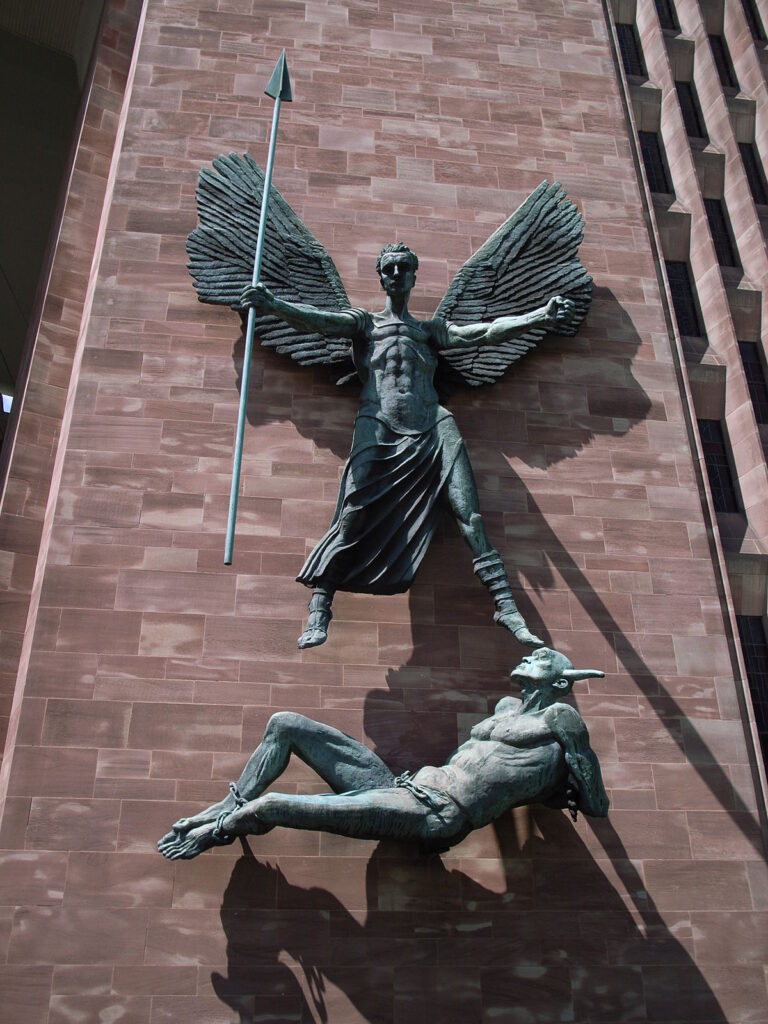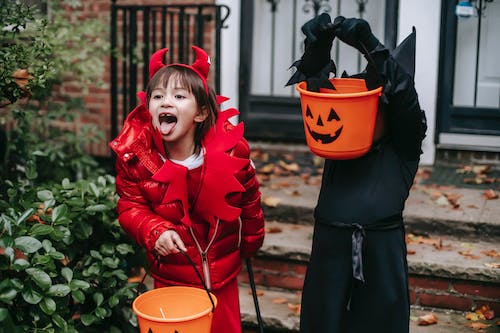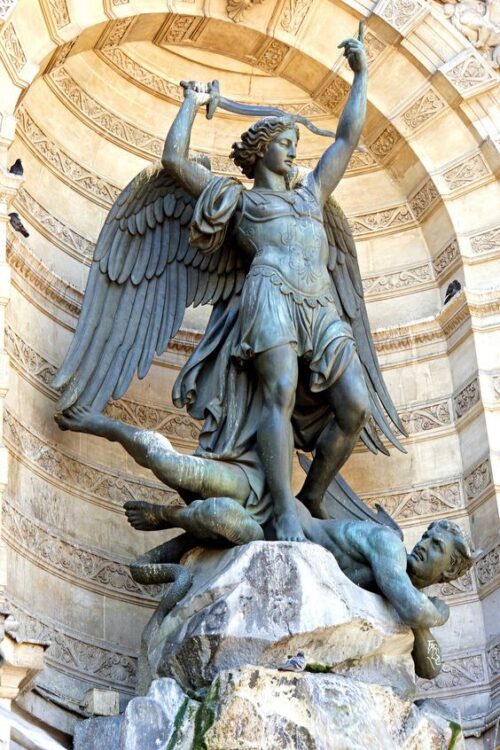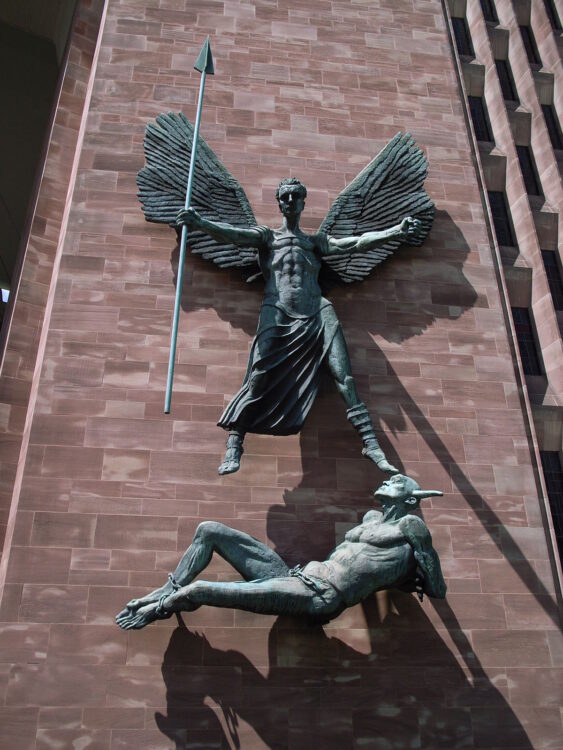Question: Could you please re-post your “Frank Answer” about Christians celebrating Halloween? I really enjoyed seeing that on the Immanuel web site. Thank you very much.
Frank Answers: Sure, this article appeared on the Immanuel Lutheran Church web site in 2012 as a “Frank Answer.” It was reposted on the old “Frank-Answers” blog. I might as well keep it alive and post it again on this new “Frank-Answers.” I also point out that I wrote a new article about Halloween on this bog, that focuses on the relationship between Halloween (the Eve of All Saints’ Day) and death, including the Celtic lore about the death of Earth at this time of the year. See https://frank-answers.com/frank-answers-about-halloween-and-death/
Here is the original question.
Question: Halloween is all about ghosts and goblins, witches and devils, horror and fright. Is this the sort of holiday Christians should be observing?
Frank answers: Halloween is not a church observance, but it is of Christian origin. The very name means “All Hallows’ Eve” (from old English), the Eve of All Saints’ Day. All Saints’ Day developed in the early medieval Western Church as a day for honoring all the saints.
The idea of an All Saints festival was introduced in Rome in the year 609 and was originally celebrated on May 13. But such a day was being celebrated on November 1 in the Frankish Empire and in Britain in the eighth century and in 835 it was recognized as a universal feast in the Western Church by Pope Gregory IV. Some have suggested the date of this observance was due to the influence of the Celtic Church and was intended to be a means of countering the pagan Samhain observance, which marked the end of the harvest, the change of seasons and the coming of the darker time of the year.
There was a widespread folk belief in Europe, including in the Celtic culture, that at the turn of the year as the cold of winter approached, the spirits of the departed come looking for warmth. Contrary to modern superstition, ghosts do not haunt houses, they haunt people. Apparitions of ghosts mainly had to do with the deceased seeking vengeance on the living for not honoring provisions in wills or just benignly reconnecting with family members. After the spread of Christianity ghosts might visit to ask for the prayers of their relatives to hasten the transition of their souls from Purgatory to Heaven. These apparitions continued throughout the Middle Ages.

The problem was that Christians were taught to have no in interaction with the spirits of the dead.
The most well-known incident in the Bible of using a medium to conjure the spirit of the departed is in 1 Samuel 28 where King Saul asks the witch of Endor to summon the spirit of the great judge and prophet Samuel. Samuel was annoyed that his sleep of death had been disturbed and asked Saul what he wanted. Saul told the spirit of Samuel that he had to face the Philistines in battle and he had no word from the Lord. Samuel’s message to Saul was that the Lord had rejected him as king and anointed David in his place and Saul would lose the battle with the Philistines. Samuel then returned to his sleep of death. Not only should we not be conjuring the spirits of the departed, but we might not like the message they have for us.
The spirits of the dead were frightening to living, and All Saints’ Day turned the attention of Christians to the veneration of the faithful departed who were in God’s keeping rather than the spirits of dead relatives. The saints would not harm the living but only intercede for their good. The faithful asked the saints for their help with various needs. The living did not expect to be visited by the souls of the saints which were in God’s keeping (Heaven). That’s why contact with the saints required venerating relics of the saints—pieces of their bodily remains.
Protestant Reactions
Lutherans remember that the Elector Frederick the Wise of Saxony had a huge relic collection which was displayed in All Saints’ Castle Church in Wittenberg. Pilgrims who venerated the relics netted indulgences worth thousands of years off from time in Purgatory. It was on All Saints’ Eve that Martin Luther posted his Ninety-Five Thesis against the sale of indulgences and started the Reformation. This event is regarded as the opening shot of the Reformation. October 31 has entered Lutheran calendars as Reformation Day (usually celebrated on the preceding Sunday). Luther’s attack on the sale of indulgences (granting years of reprieve from Purgatory) led logically to the attack on the very concept of indulgences (a form form remitting penances after death), on the authority of the pope to grant such remittances, and to questioning the very existence of Purgatory (as a place of purifying the soul before it can go to Heaven).

For those whose souls were presumed to be in Purgatory people wanted to provide what social historian John Bossy called “charity for the dead” by arranging votive requiem masses in their behalf or providing endowments for monasteries. By the beginning of the 11th century a day for all souls was added to the calendar on November 2. All Souls’ Day spread rapidly through the influence of the widespread network of Cluniac monasteries. It was a day on which to offer votive masses and prayer offices for the repose of the souls in Purgatory and to maintain the graves in the churchyards.
Protestants objected to the superstitions associated with All Saints’ and All Souls’ Days. Protestant views undermined the whole ritual industry of death in the Catholic Church. Nevertheless, Protestants believed in devils and witches as much as the Catholics did. We had on American soil the infamous witch trials in Salem, Massachusetts between February 1692 and May 1693, conducted by Calvinist Puritans, which resulted in the executions of twenty people, fourteen of them women, and all but one by hanging.
All Souls’ Day was abolished by Protestants, along with the belief in Purgatory, indulgences, and the offering of votive masses. But All Saints’ Day remained on Anglican and Lutheran calendars. In modern Protestant practice All Saints’ Day has actually absorbed the function of All Souls’ Day by providing an opportunity to remember the faithful departed in the parish family.
In Hispanic practice All Saints’ Day launches an entire month of the dead. It is really an extension of All Saints’ Eve, All Saints’ Day, and All Souls’ Day. Families come together to remember deceased family members, pray for them, celebrate with the favorite foods of the departed, and arrange memorabilia such as photos and mementos. The Day of the Dead is a public holiday in Mexico with parades and fiestas.

The Essential Elements of Halloween
The essential elements of Halloween as we celebrate it are jack-o-lanterns and treats. These aspects of Halloween go back to the Middle Ages. The jack-o-lanterns were intended to frightened away the spirits of the dead. But in case these spirits made it through this barricade, people put out treats to placate them so that the ghosts would not play nasty tricks. The idea of dressing in costumes was undoubtedly to disguise oneself so that one wouldn’t be recognized by the spirits of the deceased. The church officially discouraged this kind of superstition but parish churches cooperated with these folk customs by ringing the church bells all night to encourage the spirits of the dead to remain in their graves and to ward off evil spirits.

“Dem bones are gonna rise again.”
The holiday has continued to be observed, shorn of its religious connotations. As it is observed now, it is simply a fun day to carve pumpkins, dress up in costumes, and go trick-or-treating. As with other holidays, mass commercial culture has made more of the holiday than is warranted. Through global commercial networks, Halloween in its uniquely American guise has spread throughout the world. The remarkable thing about this holiday is that no one officially sponsors it. It is not a church festival. It is not a civic holiday. It is just observed, from one generation to the next, for the fun of it. In the rational, technological world in which we live, having a day that immerses us momentarily in mystery—the interplay between life and death, good and evil—strikes me as not a bad thing. I think Christians can enjoy Halloween along with everyone else.
That said, adults have taken over Halloween with their own parties held in homes and pubs with their own costumes, decor, food, and drinks. They can be fun and maybe over the top.

All Saints Costumes
I don’t think the churches need to get involved with anti-pagan Halloween parties. But if they do sponsor Halloween parties I could see an opportunity for the children and youth (maybe even adults) to learn about and dress up as their favorite saints. This is, after all, the Eve of All the Hallowed (made holy) ones. There’s plenty of gore in the stories of the martyrs to satisfy the most ghoulish imaginations. Think of headless John the Baptist (accompanied by Salome the dancing girl carrying the severed head on a platter), or St. Sebastian with arrows protruding from his torso, or Perpetua of Carthage and her slave Felicity torn apart by wild beasts. For boys who like to dress up as soldiers there’s St. Martin of Tours who cut his military cloak and gave half of it to a beggar. For girls who like to dress up as a princess there’s St. Elizabeth of Thuringia (also known as St. Elizabeth of Hungary) who devoted her short life to the care of the sick. While he’s not a canonized saint, a Protestant kid might dress up as Martin Luther in a friar’s habit with hammer in one hand and the Theses in the other. Adolescents with imagination and good makeup kits could come up with spectacular costumes.
More parishes are sponsoring All Saints’ parties, or are inviting children to come to worship on on the Sunday before Halloween or All Saints’ Day or Sunday dressed as their favorite saint.

Maybe like in the Medieval Church, it’s time to trot out the saints in place of vampires, werewolves, zombies, Freddie Kruggers and chain saw murderers. There could still be the devil. He is, after all, a biblical figure. But maybe also an archangel Michael with weapon in hand prepared to do battle against Satan.

Who says Satan can’t be feminine? Angels have no gender, and Satan is a fallen angel. This devil is very beguiling.

But St. Michael will resist and defeat her.
According to Revelation 12:7-10 Michael and his angels fought a war in heaven against the great dragon, “that ancient serpent, who is called the Devil and Satan, the deceiver of the whole world,” and threw him down to the earth, and his angels with him. That’s why the devil “prowls around like a roaring lion seeking someone to devour. Resist him firm in your faith.” – 1 Peter 5:8-9a
Some of the frightful entities that we dress up as on Halloween still lurk the earth. We should take them seriously. But, as Martin Luther said, “The best way to drive out the devil, if he will not yield to texts of Scripture, is too jeer and flout him, for he cannot bear scorn.”
Pastor Frank

Archangel Michael defeats Satan and throws him bound down to Earth. Sculpture on the wall of Coventry Cathedral, England





